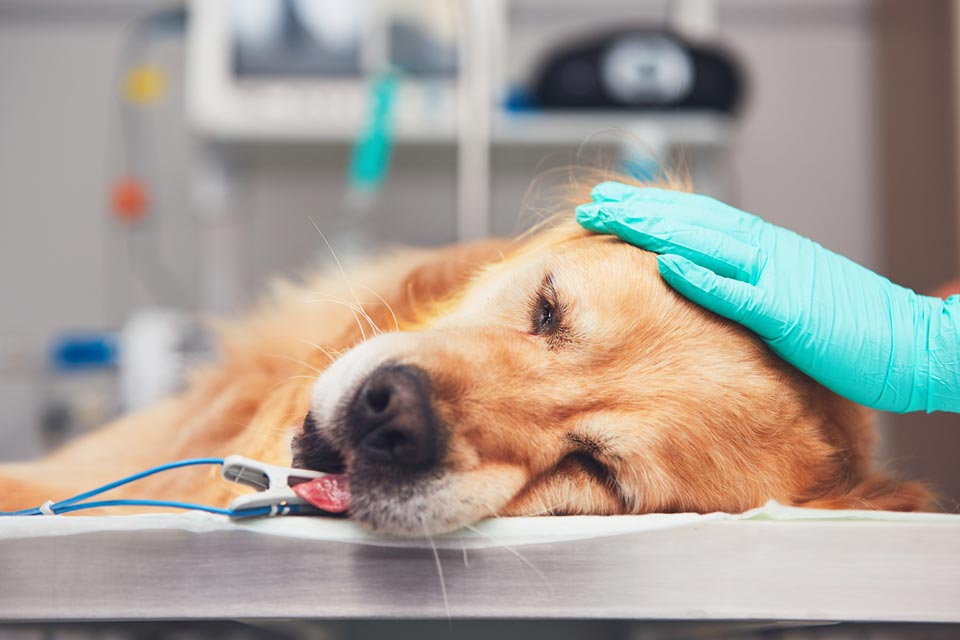Anesthesia in Dogs

Anesthesia is the process by which nerve function is depressed so a dog doesn't feel something that is being done to him. If your dog needs anesthesia, it can be a bit scary, but if you know the risks and benefits, it can be easier to make a decision.
When Is Anesthesia Necessary for Dogs?
Dogs need anesthesia when they are going to undergo a procedure that would otherwise be painful, such as surgery. They might need it to keep them still for a diagnostic test such as an MRI. Sometimes aggressive or very fearful dogs need mild anesthesia for restraint so they can be groomed or have necessary veterinary tests or care provided.
Is Anesthesia in Dogs Safe?
There are always risks when any anesthetic is administered to a dog. These risks can include mild allergic reactions at the site of injections, decreased cardiac function, and death from cardiac or respiratory arrest. Dogs that have eaten recently prior to general anesthesia are at risk of vomiting and then inhaling the vomit, which can result in a life-threatening aspiration pneumonia.
Anesthesia may increase the workload on the kidneys and liver, and if those organs are already functioning below capacity, that can lead to failure of those organs.
Rarely, anesthesia can cause seizures or long-term vision problems in dogs.
What Types of Anesthesia Are Used in Dogs?
Anesthesia may be general or local.
- General anesthesia results in loss of consciousness.
- Local anesthesia results in loss of feeling in a small area.
General anesthesia is performed when the dog needs to be completely still or when a large area of the body will be affected by the procedure. An example of when general anesthesia is necessary is when abdominal surgery is performed.
Many times, general anesthesia in a dog is accomplished by first giving a sedative intravenously to put him under and then placing a breathing tube down the dog's windpipe through which is pumped a mixture of gas anesthesia and oxygen to keep him asleep. The gas is halted when it's time for the dog to regain consciousness.
Local anesthesia is used when a small area of the body will be affected by the procedure and the dog isn't required to be completely still. For instance, if a dog has broken a nail that needs to be trimmed back and bandaged, an injection to numb the nerves in the toe might be given.
Sometimes both general and local anesthesia are used. An example of this is might be when a dog has some teeth pulled. General anesthesia will be necessary so the dog is immobile and the mouth can be manipulated during the surgery, and a local nerve block of the affected teeth may be done to further block pain for the dog.
What Types of Monitoring Can Be Done in Anesthetized Dogs?
There are many ways a dog can be monitored during anesthesia to ensure that his body is handling it well and to make adjustments if any warning signs occur. These include:
- Assigning a veterinary technician or assistant to visually monitor the dog at all times. This person will take a heart and breathing rate routinely and adjust anesthetic or let the veterinarian know if those numbers indicate the dog is having difficulty.
- An ECG machine may be used to monitor the dog's heartbeat. The presence of abnormal beats, arrhythmias, may indicate a problem.
- A blood pressure monitor can be kept on the patient. Blood pressure should not be allowed to drop too low during canine anesthesia.
- Body temperature drops during anesthesia, and if it gets too low, it can negatively affect the functioning of the dog's body systems and his ability to wake up. Taking a temperature periodically throughout the anesthesia time can allow the staff to adjust conditions to keep the dog warm.
- A pulse oximeter can be attached to the dog during anesthesia. This machine gives information about the oxygen levels in the dog's blood and his heart rate, allowing the human monitor to make adjustments in anesthesia and oxygen delivery as needed.
How Can Anesthesia Be Made Safer for a Dog?
Using the above monitoring techniques and having a human assigned to monitor the dog at all times during the anesthesia can make the procedure safer. Additionally, having a blood workup done prior to anesthesia can help reveal any kidney or liver dysfunction that might make it riskier. The veterinarian might choose to avoid anesthesia or he or she might make different anesthetic agent or dosage decisions based on such pre-anesthetic testing. Keeping a dog warm during and after anesthesia is critical for helping him handle the anesthetic well, and blankets, warming pads, and frequent temperature checks can help with that.
You May Also Like These Articles:
MRI in Dogs: What Is It and When Is It Done?
CT Scans for Dogs: What Are They and What Information Do They Provide?
Common Blood Tests Done on Dogs
X-Rays in Dogs: What Can They Tell Your Vet?
Fine Needle Aspiration: What Is It and What Does It Tell Your Vet?
Can Dogs Sniff out Infections?
Disclaimer: This website is not intended to replace professional consultation, diagnosis, or treatment by a licensed veterinarian. If you require any veterinary related advice, contact your veterinarian promptly. Information at DogHealth.com is exclusively of a general reference nature. Do not disregard veterinary advice or delay treatment as a result of accessing information at this site. Just Answer is an external service not affiliated with DogHealth.com.
Notice: Ask-a-Vet is an affiliated service for those who wish to speak with a veterinary professional about their pet's specific condition. Initially, a bot will ask questions to determine the general nature of your concern. Then, you will be transferred to a human. There is a charge for the service if you choose to connect to a veterinarian. Ask-a-Vet is not manned by the staff or owners of DogHealth.com, and the advice given should not delay or replace a visit to your veterinarian.



